CK15
THE PAGAN gOD DEWI
Dewi: The Welsh God
--------------------------------------------------------------------------------
An old Welsh god.
The official emblem of Wales, The Red Dragon, is derived from the Great Red Serpent that once represented THE gOD DEWI.

The Red Dragon of wales Derived from the Pagan god Dewi
This Pagan diety was Christianized as St. David.
As Saint David...Little is known of his life. According to the hagiography (c. 1090) by the Welsh scholar Rhygyfarch, he was the son of the chieftain Sant, who raped David's mother, St. Non. Educated at Henfynyw, Cardigan, he seemingly took a prominent part in the synod of Llanddewi-Brefi (in Cardigan) to suppress the heresy of Pelagius (q.v.) and presided at the Synod of Victory held later at Caerleon-on-Usk, Monmouthshire, which supposedly defeated the Pelagian heresy in Britain. More certainly, he moved the seat of ecclesiastical government from Caerleon to Mynyw, which still, as St. David's (Ty-Dewi), is the cathedral city of the western see. David founded numerous churches throughout South Wales (more than 50 named for him existed in the 20th century). His shrine at St. David's became a notable place of pilgrimage. His canonization by Pope Calixtus II (c. 1120) is unproven. Source: Saint David information from Encyclopedia Britannica
.
I feel the catholic church not only misprepresented the saints by asking men to ask them to intercede for them when they were dead, but they added insult to injury by linking them to demonic pagan dieties.
THE ROOT
As far as we can tell from ancient mythology the Dragon has prevailed in all ancient pagan religions from Egypt to Babylon and even into modern day pagan christian organisations such as the Roman catholic Church , who incorporated them into their mytholgy.
The god Dewi as i have pointed out was the root of the red dragon of wales symbol , for dewi was a great red sea serpent / demon,and if we trace back the dragon myth we find it predominates in ancient cultures and even into modern day islam with the draco myth.
Our focus though is on it's relationship to Rome and so to Wales and how significant this is to Prince Charles.
In the book of revelation we are clearly told that a future king of the Empire once known as Roman , would recieve his power throne and authority from The Red Dragon.
The only country on earth that has a Red Dragon as its official power giver, is wales.
And charles Prince of wales received his power throne and authority not from the monarch of England, but specifically from the RED DRAGON who was derived from the pagan god dewi, the Great Red Dragon from the sea.
On the Origins of Dragons
What are dragons? when did they first appear as part of the human psyche? When did they first appear in the waters and on the mountaintops of the world in our cutlural myths?
People have been asking them selves these same questions for thousands of years - with no definitive answer.
There are many theories for everything. Here are just a few.
David Jones, author of Instinct for Dragons, contends that dragons are a mix of the three great predators of primates in prehistoric time: the feline, the serpent, and the predatory bird. These three were the greatest threats and once Australupithicus started walking upright, he combined aspects of these predators into one great fearsome beast - the dragon.
The Catholic church was instrumental in the vilification of dragons throughout the Middle Ages, especially in the Western World.
Above we see the question about what dragons mean, are they real? ofcourse they are only symbolic of evil, symbolic of the real power of evil , that is satan.
However that symbol has been taken up by real world empires and religions, most notably Rome and the Roman church which it spawned.
The culmination and outcome of these two entities is the final manifistation of the power of the red dragon , who is the beast king who receives his power from this dragon , which in the book of revelation is clearly said to represent satan.
This beast king who recieves his power throne and authority from the Red Dragon, will not only revive the empire of Rome that bore the red dragon symbol, but he will also unify all the false religions that have bore the dragon symbol as a god in some from or another.
Looking back in mythology, the Roman Empire was familiar with an earth-bound form of dragon that guarded buried treasure in caverns underground; while the medieval period had accounts of 'modern' dragons, winged, breathing fire, with two or four legs, etc.
The Roman dragon was evolved slowly - in the early centuries A.D. - into a Roman army standard, a flying dragon with possible fiery associations. The prototype for this may have come from Eastern provinces of the Empire or celtic influence, and it seems here we have the certain source of the 'modern' dragon's attributes of flight and fire - though wings are not yet pictured as part of its make-up. The military dragon may have been dispersed throughout the Empire of the time, or it may have been handed on through Byzantine and later Carolingian learning.
The history of the nations of the Mediterranean countries from B. C. 65 to A.D. 395, shows the power existing during this period chose to represent itself by a Dragon; we may, therefore, as Daniel has given it no name, style it for convenience THE GRAECO-ROMAN DRAGON.
Rome and chinese red dragons
There is even some evidence to suggest Romans may have even worshipped some chinese forms of the red dragon.
Did Romans Worship Chinese Dragons?
Until now there has been no proof that the Romans ever set foot in China before the Christian era, recent reports from Gansu provence indicate that a group of Romans offered their services to the Hun warlord Jzh Jzh in 36 B.C. before settling in the Gansu village of Liqian, thought by some to be Lou Zhuangzi.
The idea that some of the 10,000 Roman prisoners taken by the Parthians after the battle of Carrhae in southeastern Turkey in 53 B.C. made their way east to Uzbekistan to enlist with Jzh Jzh was first proposed in 1955 by Homer Hasenphlug Dubs, An Oxford University professor of Chinese history.
Chinese accounts of the battle, in which Jzh Jzh was decapitated and his army defeated, note unusual military formations and the use of wooden fortifications foreign to the nomadic Huns.
Dubs postulated that after the battle the Chinese employed the Roman mercenaries as border guards, settling them in Liqian, a short form of Alexandria used by the Chinese to denote Rome.
Most Chinese scholars have been critical of Dub's hypothesis, others went so far as to identify Lou Zhuangzi as the probably location of Liqian in the late 1980s.
Many of the Roman soldiers worshipped Mithra , god of light and justice. The Sun brings light and warmth, it also brings scorching heat and destruction. Its rays are often called arrows. Light and darkness are at war with one another. So religions focusing on the Sun have often tended to militarism.
When the Roman mercanaries settled in the windswept area of China they were in fact syncretists and adopted Chinese beliefs, Chinese practices and married Chinese women. They were drawn to the Chinese dragon, which represents the East, the Sun, and the bounty of the land. They found kinship with the blue Heavenly Dragon which guards the celestial mansions of the gods, as they guarded the borders of China. Just as the Sun, in its all-embracing power, could speak of peace as well as war. The Romans, strangers in a strange land, were drawn in the direction of universalism and toleration. What is more, the all-seeing eye of the Dragon (Sun) made for justice. These Romans were particularly strong about keeping one's word, about the value and importance of truth, honesty, uprighteness. They made good neighbors to the Chinese of the area and unlike most foreigners were easily assimilated. And today there is no one in Ganzu province who is fair, blond-haired, blue-eyed, and an obvious descendant of these Roman mercanaries.
There is the remains of a temple built along "dragon lines,"in the county capital of Yongchang; containing Roman artifacts, including pottery shards, weapons, implements associated with the worship of Mithra, and portions of a frescoe showing a blue dragon attended by men dressed as Roman soldiers. No academic papers have been published, and no archaeological investigation has been conducted on this temple.
Chinese authorities have refused to comment on the temple and persistent reports that a small dragon population, largely living in wells, still remains in the area. Foreigners attempting to visit the temple or inquire about dragons are given the Chinese equivalent of, "Don't let the sun set on your back before you're out of town!" Chinese citizens are forbidden, on pain of imprisonment, or worse, to join Dragons Unlimited. And, if a tourist were to reveal membership in Dragons Unlimited he or she would be barred from entering the country.
Interestingly enough County officials, sensing potential tourist revenue, have erected a Doric pavilion in Lou Zhuangzi, while the county capital of Yongchang has decorated its main thoroughfare with enormous statues of a Roman soldier and Roman woman flanking a communist party official.
The Arch Of Titus
below is a paper describing an illustration on the Arch of titus which commemorates Titus victory over the jews and the romans taking the jewish MENORAH out of the second temple.
Titus destroyed the Temple and an arch was built in his honor. On the arch there is a bas-relief showing the spoils he bought home from Jerusalem. This depicts a Candelabrum with seven branches, which curve upwards in the familiar semi-circle. It is likely that the famous Roman arch influenced the way people later depicted the Menorah.
Ancient Jewish sources indicate that there were many Candelabra in the Temple. They may well have been made in different ways. According to the Rabbis, the Menorah, the one that was in the holy section of the Temple, was nearly five foot high, and had straight branches.
It has been suggested that the illustration on the Arch of Titus is of a different, smaller candelabrum. The bas-relief shows a candlestick with a dragon on its base. The dragon was a Roman symbol. The artist who sculpted the Arch may never have seen a Jewish Menorah, but simply used his own imagination.
It is a pity that this has influenced the way Jews think of one of the most important items in the Temple, constructed with the guidance of a vision from G-d. However, now that the error has been noted, we can gradually set the record straight!
What really went on there? does this mean titus desocrated the temple and the menorah with a red dragon?
possibly.
We already know that the legions that Titus led were carrying the red dragon banner , they brought down from wales and the ancient Brittania area in general .
The writers above , seem to think this depiction of a dragon on
this Holy Jewish Menorah, was due to lack of understanding of judaism, but
i think it could mean more than that. CK15
The English kings and the dewi Red dragon
I believe the modern Welsh flag is directly derived from the Tudor standard.
Roy Stilling, 14 July 1998
Dragon Standards were used in the later Dark Ages and early Middle Ages as a visible statement that no quarter (no mercy) would be given or expected. That is, 'No Prisoners'. Whether this has any connection to the Welsh Dragon I do not know... As far as I know the Welsh Dragon was the personal badge of the High King of the Romano-Britons, who was also known as the 'Pendragon' (German translation of Oberdrachen or Over- Dragon is as good an explanation as any). Dragons are of course very popular in mythology and legend and the whole 'Pendragon' thing is very much mixed up in Arthurian legends, and it is hard to say how much is historically accurate.
As far as Roman standards are concerned, the Eagle of the Legion was also adopted on a large scale, (see Army, Air Force, Arms) not only in Britain, so it is to be even more expected that the Dragon of the Cohort was adopted, because cohorts, unlike Legions, could also be exclusive to a local area - an example might be the Xth (Gaulish) Auxiliary Cohort - and the men of this cohort, after being demobbed, might well take the symbol home with them.
Anyway, I'd like to add I'm more inclined to believe that Dragon standards have an even older origin than the Romans, in Britain or Germany, when one considers the prevalance of 'dragon- slayer' myths, it is likely that some of these old heroes adopted the dragon as their symbol.
Calum Slinn, 5 April 2000
The red dragon symbol was found in an empire ROME, many cultures and even the pagan churches of rome and the church of england.
Herod the Great, the King of Judea and Palestine was the agent Satan used in his attempt to kill the infant Jesus. It is significant to note that Herod received his office from the Roman Empire. In 37 B.C. Herod the Great conquered Jerusalem with the aid of Roman armies and made himself king.
Now notice again in Rev 12:3 that Satan is described as having seven heads, ten horns and seven crowns. This is important because it is a key to identify Satan and his agents elsewhere in Revelation:
Rev 13:1 And I stood upon the sand of the sea, and saw a beast rise up out of the sea, having seven heads and ten horns, and upon his horns ten crowns, and upon his heads the name of blasphemy.
Rev 13:2 And the beast which I saw was like unto a leopard, and his feet were as the feet of a bear, and his mouth as the mouth of a lion: and the dragon gave him his power, and his seat, and great authority.
Here another agent of Satan can be found. Although nearly identical in description, it is not Satan, because verse 2 says this beast power gets his power from the dragon - a clear reference to Satan. As we observed in Matthew, Satan used the power of the ancient Roman Empire to attempt the murder of Jesus. The dragon and Rome worked with the same mind toward the same goal. So in Rev 13:2 we can possibly substitute Rome for the word Dragon. Lets explore a little farther.
Note the animals that are mentioned. This is a reference back to Daniel 7. John the Revelator was looking backwards in sequence at the previous empires, to give us a time hack if you will, to identify this Sea Beast in the stream of time. The Lion (Babylon) is referred to as the head of Gold in Dan 2, the Bear (Medo-Persia) which is also the chest of silver in Dan 2, and the Leopard (Greece) the thighs of brass in Dan 2. Now there is also a fourth beast in Dan 7, to match the legs of iron in Dan 2 -
Dan 7:7 After this I saw in the night visions, and behold a fourth beast, dreadful and terrible, and strong exceedingly; and it had great iron teeth: it devoured and brake in pieces, and stamped the residue with the feet of it: and it was diverse from all the beasts that were before it; and it had TEN HORNS.
This fourth diverse beast with ten horns correlates to ancient pagan Rome. Ancient pagan Rome, when it disintegrated, was followed by the divided kingdoms, which is to say a divided Europe (a condition that exists today)(ammendmant this was written before the present unifying powers in europe had started there rapid work we see today- (CK15), represented by the feet and TEN TOES of clay and iron in Dan 2.
Also both the beginings of both the Roman Catholic Church and so even the church of england can be traced back to constantines conversion.
The Winged Dragon and Rome
In 312 A.D. Emperor Constantine was about to enter into battle with his rival emperor Maxentius. Greatly outnumbered by his opponents army, Constantine on the day before the impending battle saw a vision in the sky of a cross with the words "In Hoc Signo Crucis Vinces" emblazoned about it, which means "In This Sign (the Cross) You Shall Conquer". Constantine immediately adopted the cross as his emblem and had it put on troops and banners. The following day Constantine defeated Maxentius in the battle of Milvian Bridge. Constantine went on to declare Christianity the state religion of Rome and was himself later baptized a Christian.
A fresco in the Vatican, (The Sala di Constantino, Palazzi Vaticani, Rome) painted by RAFFAELLO (1509-10 A.D.) depicts the moment that Emperor Constantine saw the cross in the sky. A picture of this fresco is online at at the Catholic site Christus Rex - The Cross appears to Constantine

In the fresco, note what is in the upper right-hand corner (and shown above). There you will see a winged serpent, or dragon. Raffaello was depicting a pivotal moment in the conversion of Pagan Rome to Christianity, the dragon he painted being symbolic of ancient Pagan Rome.
i have the full fresco here for your convenience , and seeing it my self, something struck me as soon as i viewed it,
notice the symbols on the gold curtian below, dont they strike you as depicting a horned creature not dismilar to a goat? or a creature with two horns at least.It seems the artist may have been given divine orders and guidance here. (CK15)
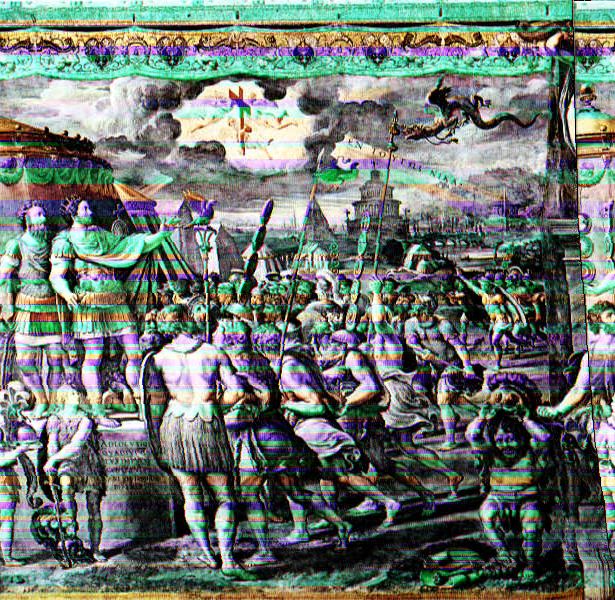
Curiously, one of the Popes adopted the winged serpent or dragon as his symbol on his heraldic shield. Here is the heraldic coat of arms of Pope Gregory XIII, 1572-1585 A.D(see below )., who is most known for initiating the calendar reform in use today, the Gregorian calendar. This is something you can confirm in the book The Pope Encyclopedia by Matthew Bunsen, published by Crown Trade Paperbacks, 1995, ISBN 0-517-88256-6, page 163.

The coat of arms of Gregory XIII shown here (below) is one of two that can be found above the doors in the Gallery of Maps in the Vatican. Revelation 12 clearly tells us that the dragon is symbolic of Satan, so why did a pope use it as his symbol?

In 1582, by decree of Gregory XIII (Inter Gravissimas), 10 days were dropped from the calendar, and a new system of leap years was inaugurated.
Below a horned creature like in the fresco above ?

GREGORIUS XIII
PONT(IFEX) OPT(IMUS) MAXIMUS ANNO RESTITUTO MDLXXXII
(notice the dragon on bottom of the coin on the right, here depicted with webbed wings.)
(Year of Restitution 1582)
The above papal medal of Pope Gregory XIII, designed by L Parm, is dated 1582, marking the year of the Gregorian calendar reform. On the reverse of the medal is a winged dragon / serpent encircling a ram's head. As previously mentioned, the dragon is the biblical symbol of Satan (Rev 12:9). The serpent that is chasing or devouring its tail is called Ouroboros, Uroboros, or Oureboros. The ram's head is also a satanic symbol, and is frequently associated with the Egyptian deities, such as the god Amon (Amoun, Ammun, Ammon), the king of all gods, who was also regarded as the sun god, and Khnum, who created mankind on his potter's wheel from the mud of the Nile.
The intended symbolic meaning, however, is undoubtedly that of Aries the Ram, the first sign of the Zodiac, which symbolizes the Vernal / Spring Equinox, and Draco / Drako (or Ouroboros) the serpent depicting a cyclical returning. Pope Gregory XIII had modified the calendar specifically so that the Vernal Equinox would remain relatively constant, on or about March 21st, which is the beginning of the Zodiacal year, when the Sun crosses the Equator and enters the astrological sign of Aries. This had the desired result of returning Easter to the time specified by the Nicene Council (325 A.D.).
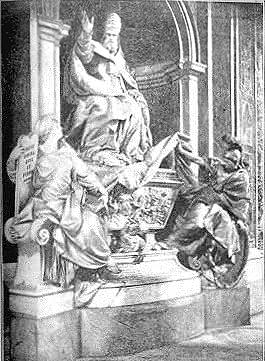
Here is the tomb of Pope Gregory XIII which celebrates the Gregorian Calendar reform, and above is a close up of the guardian dragon (like Queen elizabeths II guardian Dragon )near the base of the monument. At the top of the monument is a large heraldic shield for Gregory XIII, which contains the winged dragon, a symbol of Satan.
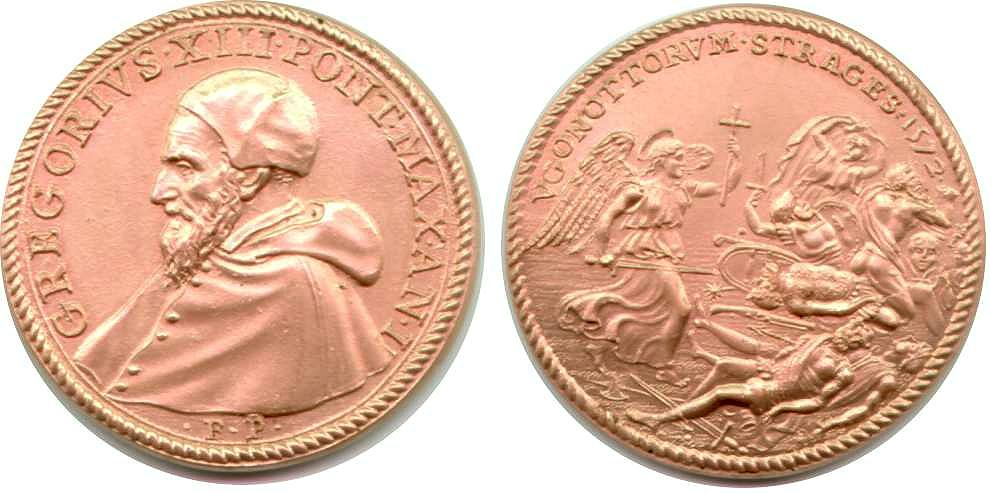
Pope Gregory XIII, with the dragon of Satan as his heraldic symbol, was also the pope who upon hearing of the wholesale slaughter of Protestant French Huguenots, known as St. Bartholomew's massacre, had a medal struck to celebrate the bloody event. The reverse side of the medal, shown above, depicts an angel with a cross and sword murdering the Huguenot heretics.
To his credit, while in Paris to celebrate the 12th World Youth Day on Saturday, August 23rd, 1997, the eve of the anniversary of the massacre, Pope John Paul II made a brief apology for the acts of French Catholics 425 years before, by admitting that "Christians did things which the Gospel condemns."
A second pope, Paolo V (1605-1621) also used a winged dragon on his heraldic shield along with an eagle. In the Vatican Gardens there is a fountain called the Fountain of Towers, bearing the inscription and papal shield of Paolo V, in which the central figure of the fountain is a winged dragon centered in water spouts. Flanking either side of the fountain are fortress like towers topped by sculptures of winged dragons. (see below.)
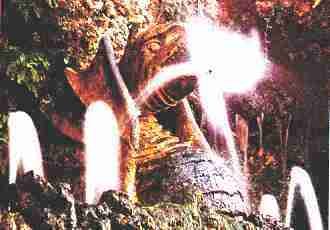
Photo by Mario Carrieri
What happened to the Red dragon When it transfered from Rome?
THE DRAGON IN THE CITY OF LONDON
For instance The City of London has The Dragon as its symbolism .
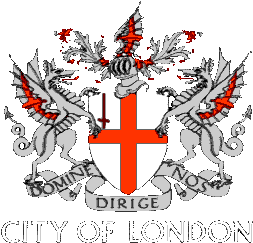
The heraldic Dragon of London has "Domine dirige nos" (O Lord guide us) written underneath. Making the Dragon as a god to guide them, with specific term lord associated with the image of a dragon.
It even used to be on the crests of the British monarchy before it was transfered to wales specifically in 1952 when Queen elizabeth the II officially made it the symbol and flag of wales.
The Queen's Beasts:
From the time of earliest human civilization, depictions of certain animals — real or imaginary — were used as symbols of royalty and power. Such "beasts" were among the earliest icons used in medieval heraldry. The Tudor monarch, Henry VIII (1509-1547), commissioned carvings of those beasts most closely associated with British royalty, to decorate his palace at Hampton Court. These were the inspiration for the human-size Queen's Beasts sculpted in plaster to guard Elizabeth II's entrance into Westminster Abbey at her Coronation in 1953. A duplicate set was given to Canada.
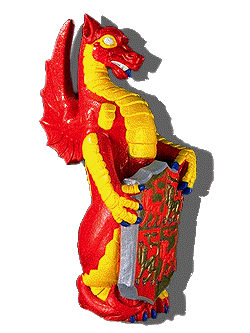
The above is one of the dragons used to guard elizabeth II, as she was coronated in 1953.
The long history of Dragons and the English throne is evident by the heraldic use of these symbols of past empires , Rome most notably used the red dragon symbolism as did the ancient babylonian civic and religous institutions ,primarily the roman empire connection made way for the Holy Roman Empire's use of the dragon symbolism headed by the Kings of Europe and the Roman catholic Popes whom they served under oath on beneded knee.
More examples of dragons within the British monarchy past.
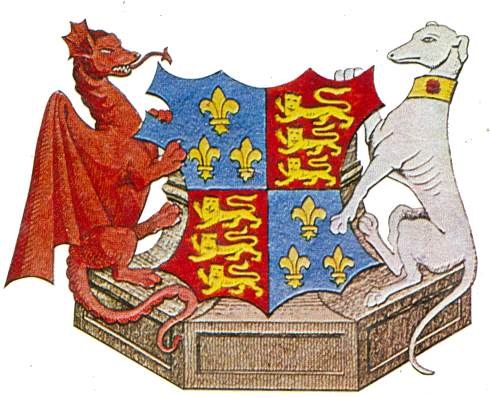
above (Henry VII (1485-1509) used Dragon supporter.
The red dragon was to show that Henry was descended from Cadwalader last native King of Britain.
In one form or another, dragons are legendary the world over. In the Early Middle Ages, the rulers of Britain featured the dragon — a symbol of power, strength and wisdom 3 on their war-standards. In particular, the princes of Wales used dragons on their heraldic arms. The Tudors, who claimed descent from those princes, included the dragon as their family crest; Henry Tudor fought under the red dragon standard when he won the English crown at Bosworth (1485), and added the beast to the existing heraldic menagerie of the monarchy. It is today the official symbol of Wales.
Although in times past the red dragon had been seen in english helradry, the connection with wales nd cheifly the prince of wales , is a relatively modern occurance.
"While the warriors, chiefs and princes of Wales were constantly called 'dragons', we do not have any clear evidence to prove that they ever used a dragon, let alone a red dragon, as a military standard at any time before the fifteenth century. It is perfectly likely that it may have happened, but the literary and historical documents which we have contain no unambiguous reference to the use of a dragon banner by Welsh resistance fighters until 1401."
"The arms of Llewelyn's [the Last, proclaimed the first Prince of Wales in 1258, died 1282] father, Gruffudd ap Llywelyn Fawr [of the royal house of Gwynedd], were sketched by Matthew Paris (died 1259) and they show, quarterly or and gules (i.e. gold and red) four lions passant counterchanged. ... there is no dragon in the arms of Gwynedd. ...
Ofcourse this doesnt mean that there was no unoffical assocition within wales with the red dragon, for as has been said The Red Dragon is erived from the celtic god Dewi the great red sea serpant, however the history of that particular celtic demon must go farther back into the annals of ancient times and distant lands, because the Roman legions although they adopted the celtic symbol of the red dragon were not unaquated with dragon myths before they took the dewi as a battle standard.
The Red Dragon within the symbolism of the british monarchy
The most notable of the britsh monarchy of past history to use the red dragon symbolism were the Tudors.
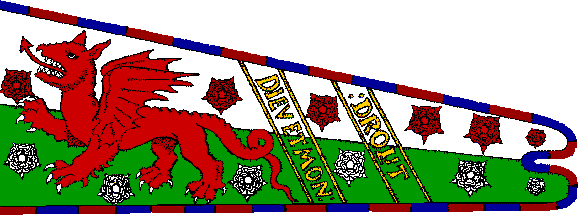
The flag of Henry Tudor.
Henry VII's grandfather, Owen Tudor, used a red dragon garnished with gold as a badge, claiming descent from Cadwalader, the last native ruler of Britain, to whom a dragon was attributed. It is not surprising, therefore, to find that Henry greatly favoured this beast. He used it as a badge and also as a supporter to his arms: he even created a new pursuivant (the junior rank of herald) whom he named Rouge Dragon. Henry used the dragon as his dexter supporter in conjunction with a greyhound. He also used two greyhounds, witness the representation of his arms at the Bishop's Palace, Exeter.
"The greyhound was a popular badge of the Lancastrian kings and when Henry VI created his half-brother Edmund Tudor, Earl of Richmond, he also assigned him a white greyhound badge as a supporter. It is not surprising that Henry should have attached especial importance to this royal beast, which he would have inherited from his father, for it symbolised, and perhaps in his eyes made more substantial, his tenuous links with the house of Lancaster.
"King Henry VIII, like his father, did not just use two supporters. He rang the changes but generally favoured the crowned golden lion as his dexter and the red dragon as his sinister supporter, which is probably why King Edward VI, Queen Mary I and Queen Elizabeth I, who made the dragon gold, all used these supporters: except that Mary, when her arms conjoined to those of King Philip gave her husband his black eagle in place of her dragon.
MORE EXAMPLES
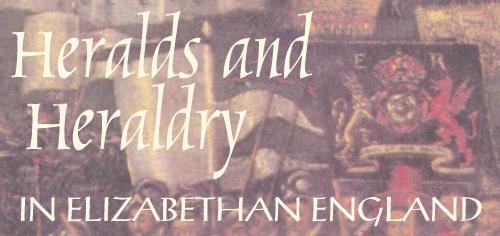

ABOVE :THE ROYAL ARMS C. 1572 WITH DRAGON SUPPORTER
Y Ddraig Goch (the red dragon) is the national flag of Wales, and has been officially recognised as such since the 1950s. The white-over-green field is in the livery colours of the Tudors, the Welsh dynasty that once sat on the English throne.
Roy Stilling, 27 November 1995
Conventional wisdom is that the 'draco' standards of the Romans were adopted by the Britons, probably as a metal (possibly real gold) head with a windsock type of body made of silk. In the mouth was a whistling type device that would make sounds as it was waved with vigor. Supposedly used by King Arthur, certainly used by the Wessex lords in the 700s, the emblem has been used by Britons right up recent past , and by wales at the present time.
Dave Martucci, 27 January 1998
A dragon was the standard of a Roman cohort which was a tenth of a legion. After the Romans left Britain it was used by both the Britons and the Saxons. A golden dragon was the principal war standard of the Saxons of Wessex, and was carried by them at the battle of Burford in 752. In the eleventh century battles the king positioned himself between his personal standard, which was the rallying point and the dragon standard which was carried by a standard bearer chosen for his strength and prowess. After the battle of Hastings the dragon standard was adopted by the Normans. No record of its use in Scotland after the battle of the Standard in 1138,where it was borne as the Scottish royal standard. A dragon standard was taken on the Third Crusade by Richard I in 1191. A dragon was borne by the English army at the battle of Lewes in 1216 and later Henry III had a dragon standard made to be placed in the re-built Abbey at Westminster. Used by Edward I, Edward III at the battle of Crécy 1346, Henry V at the battle of Agincourt 1415, and at the battle of Bosworth in 1485, after which it was carried in state to St Paul's Cathedral. Henry VII displayed the red dragon of Cadwallader, from whom he claimed descent, on the Tudor colours of white and green. Until this time it was probably golden. The supporters of the English royal arms were a lion and a dragon, but the latter was replaced by a unicorn for Scotland by the Stuarts. The dragon reappeared briefly as a supporter of the arms of the Commonwealth under Cromwell.
Today the dragon is the most prominent Welsh symbol. It is an ancient symbol, already prominent across England and Wales in the years after the departure of the Romans. With the invasions of the Angles and Saxons, the ancient Britons and their dragon symbol was pushed back towards Wales.
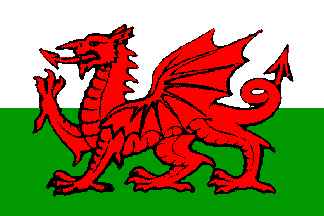
Official flag of wales.
WHERE DID THE RED DRAGON GO AFTER IT WAS REMOVED FROM THE CRESTS OF BRITISH MONARCHS?
Below is a typical version of Queen Elizabeths royal crest. As we have read, England's monarchy of past history use of the dragon symbolism is strongly evident.We now come to the present , where the dragon symbolism is not as obvious today in the Crown of the monarchs of England.
Infact the dragon is now the symbol of just one member of the royal family , and the actual giver of power of title to that one member of the british Crown. The title is that of Prince of wales, who presently is in the person of Prince charles of Wales, Queen Elizabeth's eldest son.
In this present time no heir to the throne of England can be so unless he first recieves his power throne and authority from the symbol of wales, the red dragon, this is due to the fact that every male who is the eldest son of the King or Queen of England ,becomes heir of the title Prince of wales via his heir apparent to the throne position. The title Prince of wales is not a new one, however in 1953 things changed constitutionally forever concerning that title.
Three years after the birth of her first born, Charles Philip Auther George Windsor, Queen Elizabeth II officially made the Red Dragon the symbol and power giver of wales in the year 1953.
When Charles was investitured as Prince of Wales, for the first time in that titles history, a prince of wales recieved his power, throne and authority direct from the Red Dragon of wales.
The Lion symbol of the Present British Monarchy
you will note the lion is not in the style of the leo-pard, but looks like a normal lion and its feet like those of a lion.
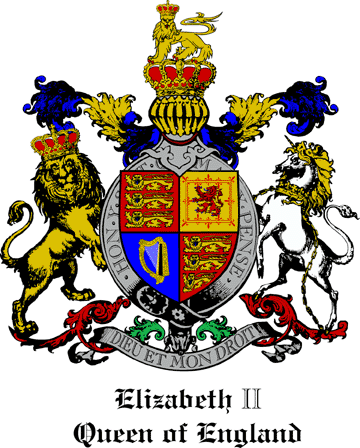 .
.
The belt surrounding the shield bears the motto of the
Order of the Garter, "Hon Y Soit Qui Mal Y Pense" or
"Shame to him who evil thinks."
The motto below, "Dieu et Mon Droit,"
means "God and My Right."
In contrast is a typical version of prince charles original crest, notice the definitive leo- pard lion with the distinctive toes.
Note :the heraldic beast in charles prince of wales crest ,has been changed on many occasions, sometimes revealing toes on the beast , denoting those common both on bears and lions feet ( according to the heraldic dictionary).
This is also true of the achievements of the rest of the royal family, in each case the hereldic lions have in turn had three then four toes.
This occured as far as i can ascertain, only after the official personal crest of the present prince of wales was published with toes on the lion beast denoting those of a bear according to the heraldic dictionary, just like the lion beast in the book of revelation.
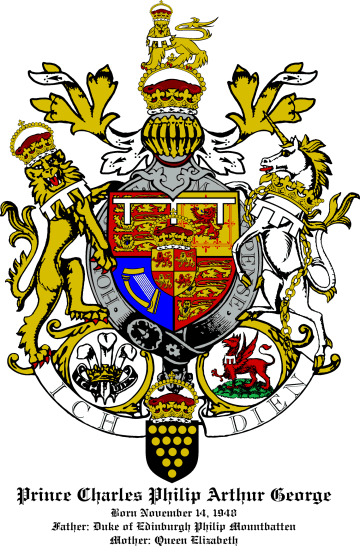
A white "label with three pendants" was added to the traditional
coat of arms for Prince Charles to denote his position
as the first-born son.
The motto below, "Ich Dien," is German for "I serve."
Here is Prince Williams crest
Prince william of wales.
Notice no inclusion of the symbol of wales this time The RED DRAGON, unlike Charles prince of Wales crest, ven though william is a prince of wales.
note the same lack of the red dragon symbolism is evident in the crest of Prince Henry of wales (Harry).
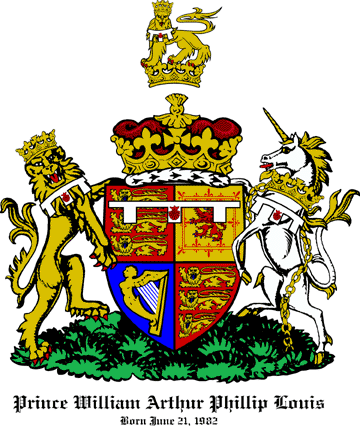
Prince William requested the addition of an "escallop gules"
(a red scallop shell, prominent in the Spencer ancestors' coats of arms)
to honor his Mother, Diana.
WHAT HAPPENED TO WALES IN THE UNITED KINGDOMS FLAG?
The Absence of the Welsh Dragon on the Union Jack
It is often noted that there is no representation of the Welsh flag on the Union Jack or Royal Standard. The reasons for this are historical - when Edward I defeated Llewelyn, he included Wales in an amalgamated kingdom, and made his son, the future Edward II the Prince of Wales. Edward, Prince of Wales', flag was quartered red lion on yellow and yellow lion on red, and is known as the flag of Llewelyn. This flag, with an escutcheon of a green shield with a crown, is used today by Charles as Prince of Wales. The emblem of three feathers and the motto "Ich Dien" was not acquired until the time of Henry I's grandson, who slew the king of Bohemia and assumed his arms.
Robin Ashburner, ICV York, July 2001
Also see The Prince and the Red Dragon.